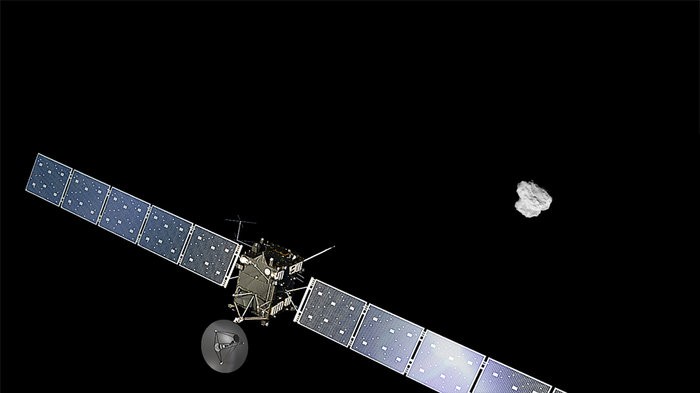Rosetta – touching down on a comet for the first time
Update: Rosetta has now arrived at Comet 67P/Churyumov-Gerasimenko, see GIF of its approach below.
Comets are about the most elusive and poorly understood objects in the solar system but in just a few hours space scientists are about to get the closest they have ever been to one.
After a ten-year, six billion kilometre journey the European Space Agency spacecraft Rosetta rendezvous with comet 67P/Churyumov-Gerasimenko. In so doing it will become one of the most ambitious and challenging space science missions ever completed.
This morning Rosetta entering orbit around the “rubber duck”-shaped comet to study it as it makes its five-yearly passage past the Sun. In November the spacecraft will release a lander to touch down on the surface of the comet itself.
It will be the first time we’ve ever made direct contact with a comet and the probe will be the first to sample what a comet is actually made of.
Comets are seriously interesting to planetary scientists because they are thought to be made from the original material that made up all of our solar system.
This animation comprises 101 images acquired by the Navigation Camera on board ESA’s Rosetta spacecraft as it approached comet 67P/C-G in July and August 2014. The first image was taken on 1 August at 11:07 UTC (12:07 CEST), at a distance of 832 km. The last image was taken 6 August at 06:07 UTC (08:07 CEST) at a distance of 110 km.
Previous research has shown comets are essentially “dirty snowballs” – lumps of water ice and dust. They also contain complex organic molecules of the type that make up amino acids, the building blocks of life on Earth. Researchers want to explore the idea of whether early comets “seeded” our planet with oceans, and possibly even life.
Rosetta’s route to 67P/Churyumov-Gerasimenko may have been precise but it’s not been direct. Since launch in 2004 it has made three fly-bys of Earth and one of Mars to “catapult” it into a huge orbital arc to catch comet 67P/Churyumov-Gerasimenko.
It spent two and a half years in deep space hibernation to save power before waking up for the arrival a few months ago.
In the coming months it will continue to orbit the comet using cameras, spectrometers and radars to study the physical and chemical properties of the comet as its surface evaporates on its approach to the Sun.
You can watch Rosetta’s rendezvous live via ESA’s website from 9 am
Follow Tom Clarke on Twitter: @tomclarkeC4

